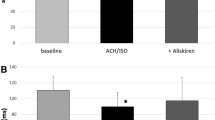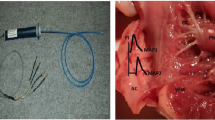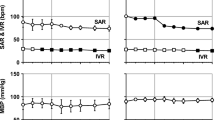Abstract
Adenosine provokes atrial fibrillation (AF) in some patients withparoxysmal supraventricular tachycardia (PSVT). Which patients are moresusceptible to develop atrial fibrillation after the administration ofadenosine to terminate PSVT is unknown. We prospectively measured atrialaction potential duration (APD) at incremental doses of 3, 6, and 12 mg ofadenosine at paced cycle lengths (CLs) of 600, 500, and 400 ms in 25patients. Bolus injection of adenosine decreased APD at 90%repolarization in a dose- and rate-dependent manner. During paced CLs of600, 500, and 400 ms, decreases of 8%, 13%, and 19% (p< 0.05), respectively, were found after bolus administration of 3 mg ofadenosine. After 6 mg of adenosine, the APD shortened by 12%, 19%, (p 0.05),and 27% (p < 0.01), respectively. After 12 mg of adenosine, the APDshortened by 15%, 27% (p < 0.05), and 38% (p < 0.01), respectively.Transient AF occurred in 4 of 25 (16%) patients, all during paced CLs of 400ms, and after adenosine 6 mg in one patient and 12 mg in three patients.Adenosine shortens atrial action potential duration in a dose- andrate-dependent manner. Whether patients with faster rates during PSVT andthose given higher doses of adenosine are more prone to develop atrialfibrillation remains to be determined.
Similar content being viewed by others
References
Belardinelli L, Linden J, Berne RM. The cardiac effects of adenosine. Prog Cardiovasc Dis 1989;32:73–97.
Clemo HF, Belardinelli L. Effect of adenosine on atrioventricular conduction. I: Site and characterization of adenosine action in the guinea pig atrioventricular node. Circ Res 1986;59:427–436.
Clemo HF, Belardinelli L. Effect of adenosine on atrioventricular conduction. II: Modulation of atrioventricular node transmission by adenosine in hypoxic isolated guinea pig hearts. Circ Res 1986;59:437–446.
Belhassen B, Pelleg A. Acute management of paroxysmal supraventricular tachycardia: Verapamil, adenosine triphosphate or adenosine? Am J Cardiol 1984;54:225–227
Belhassen B, Glick A, Laniado S. Comparative clinical and electrophysiologic effects of adenosine triphosphate and verapamil on paroxysmal reciprocating junctional tachcardia. Circulation 1988;77:795–805.
Belhassen B, Viskin S. What is the drug of choice for the acute termination of paroxysmal supraventricular tachycardia: Verapamil, adenosine triphosphate or adenosine. PACE 1993;16:1735–1741
Camm AJ, Garrat CJ. Adenosine and supraventricular tachycardia. N Engl J Med 1991;5:1621–1629
DiMarco JP, Sellers TD, Lerman BB, et al. Diagnostic and therapeutic use of adenosine in patients with supraventricular tachyarrhythmias. J Am Coll Cardiol 1985;6:417–425.
DiMarco J, Miles W, Akhtar M, et al. and the Adenosine for PSVT Study Group. Adenosine for paroxysmal supraventricular tachycardia—dose ranging and comparison with verapamil. Ann Intern Med 1990;113:104–110.
Garrat C, Linker N, Griffith M, Ward D, Camm AJ. Comparison of adenosine and verapamil for termination of paroxysmal junctional tachycardia. Am J Cardiol 1989;64:1310–1316.
Griffith MJ, Ward DE, Linker NJ, Camm AJ. Adenosine in the diagnosis of broad complex tachycardia. Lancet 1988;1:672–675.
Hood MA, Smith WM. Adenosine versus verapamil in the treatment of supraventricular tachycardia: A randomized double-crossover trial. Am Heart J 1992;123:1543–1549.
McIntosh-Yellin NL, Drew BJ, Scheinman MM. Safety and efficacy of central intravenous bolus administration of adenosine for termination of supraventricular tachycardia. J Am Coll Cardiol 1993;22:741–745.
Munoz A, Leenhart A, Sassine A, et al. Therapeutic use of adenosine for terminating spontaneous paroxysmal supraventricular tachycardia. Eur Heart J 1984;5:735–738.
Rankin AC, Oldroyd KG, Chong E, Rae AP, Cobbe SM. Value and limitations of adenosine in the diagnosis and treatment of narrow and broad complex tachycardias. Br Heart J 1989;62:195–203
Rankin AC, Oldroyd KG, Chong E, Dow JW, Rae AP, Cobbe SM. Adenosine or adenosine triphosphate for supraventricular tachycardias? Comparative double-blind randomized study in patients with spontaneous or inducible arrhythmias. Am Heart J 1990;119:316–323.
Rankin AC, Brooks R, Ruskin JN, McGovern BA. Adenosine and the treatment of supraventricular tachycardia. Am J Med 1992;92:655–664.
Sharma AD, Klein GJ, Yee R. Intravenous adenosine triphosphate during wide QRS complex tachycardia: Safety, therapeutic efficacy and diagnostic utility. Am J Med 1990;88:337–343.
Tebbenjohanns J, Pfeiffer D, Schumacher B, Jung W, Manz M, Lüderitz B. Intravenous adenosine during atrioventricular reentrant tachycardia: Induction of atrial fibrillation with rapid conduction over an accessory pathway. PACE 1995;18:743–746.
Belardinelli L, Isenberg G. Isolated atrial myocytes: Adenosine and acetylcholine increase potassium conductance. Am J Physiol 1983;244:H734–H737.
Visentin S, Wu SN, Belardinelli L. Adenosine-induced changes in atrial action potential: Contribution of Ca and K currents. Am J Physiol 1990;23:319–326.
Franz MR. Long-term recording of monophasic action potentials from human endocardium. Am J Cardiol 1983;51:1621–1634.
Belhassen B, Pelleg A, Shoshani D, Laniado S. Atrial fibrillation induced by adenosine triphosphate. Am J Cardiol 1984;53:1405–1406.
Rankin AC, Rae AP, Houston A. Acceleration of ventricular response to atrial flutter after intrvenous adenosine. Br Heart J 1993;69:263–265.
Slade AKB, Garrat C. Proarrhythmic effect of adenosine in a patient with atrial flutter. Br Heart J 1993;70:91–92
Mori T, Moriyama T, Karasawa A. Inhibitory effects of KW-3902, a selective adenosine A1-receptor antagonist, on the adenosine-induced shortening of action potential duration in guinea pig atrial muscles. Jpn J Pharmacol 1993;63:265–268.
DiMarco JP, Lerman BB, Kabell G, et al. Adenosine produces different effects on the monophasic action potential in human atrium and ventricle (abstr). J Am Coll Cardiol 1988;11:227A
Haines DE, Lerman BB, DiMarco JP. Intravenous adenosine shortens atrial refractoriness in man (abstr.). Circulation 1988;78:11–153.
Vokac D, Talajic M, Hadjis T, Dubuc M, Roy D, Nattel S. Electrophysiological effects of adenosine on human monophasic action potentials. J Am Coll Cardiol 1995;-(Suppl):383A
Author information
Authors and Affiliations
Rights and permissions
About this article
Cite this article
Tebbenjohanns, J., Malik, B., Pfeiffer, D. et al. Dose and Rate-Dependent Effects of Adenosine on Atrial Action Potential Duration in Humans. J Interv Card Electrophysiol 1, 33–37 (1997). https://doi.org/10.1023/A:1009758501195
Issue Date:
DOI: https://doi.org/10.1023/A:1009758501195




